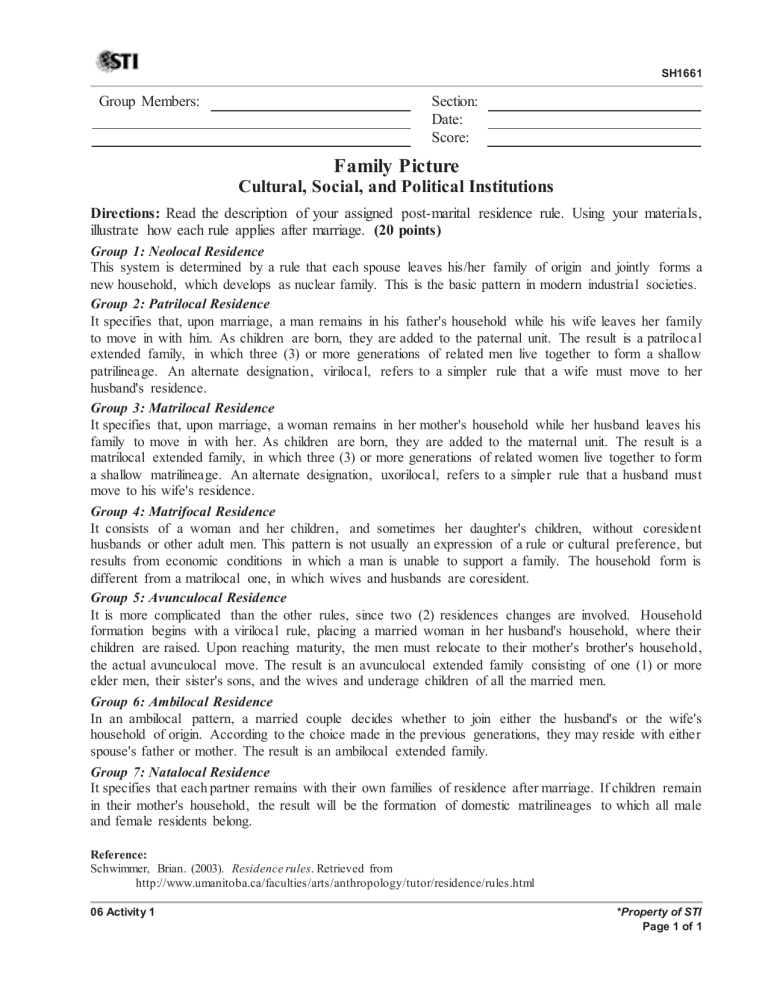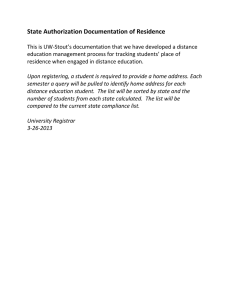
SH1661 Group Members: Section: Date: Score: Family Picture Cultural, Social, and Political Institutions Directions: Read the description of your assigned post-marital residence rule. Using your materials, illustrate how each rule applies after marriage. (20 points) Group 1: Neolocal Residence This system is determined by a rule that each spouse leaves his/her family of origin and jointly forms a new household, which develops as nuclear family. This is the basic pattern in modern industrial societies. Group 2: Patrilocal Residence It specifies that, upon marriage, a man remains in his father's household while his wife leaves her family to move in with him. As children are born, they are added to the paternal unit. The result is a patrilocal extended family, in which three (3) or more generations of related men live together to form a shallow patrilineage. An alternate designation, virilocal, refers to a simpler rule that a wife must move to her husband's residence. Group 3: Matrilocal Residence It specifies that, upon marriage, a woman remains in her mother's household while her husband leaves his family to move in with her. As children are born, they are added to the maternal unit. The result is a matrilocal extended family, in which three (3) or more generations of related women live together to form a shallow matrilineage. An alternate designation, uxorilocal, refers to a simpler rule that a husband must move to his wife's residence. Group 4: Matrifocal Residence It consists of a woman and her children, and sometimes her daughter's children, without coresident husbands or other adult men. This pattern is not usually an expression of a rule or cultural preference, but results from economic conditions in which a man is unable to support a family. The household form is different from a matrilocal one, in which wives and husbands are coresident. Group 5: Avunculocal Residence It is more complicated than the other rules, since two (2) residences changes are involved. Household formation begins with a virilocal rule, placing a married woman in her husband's household, where their children are raised. Upon reaching maturity, the men must relocate to their mother's brother's household, the actual avunculocal move. The result is an avunculocal extended family consisting of one (1) or more elder men, their sister's sons, and the wives and underage children of all the married men. Group 6: Ambilocal Residence In an ambilocal pattern, a married couple decides whether to join either the husband's or the wife's household of origin. According to the choice made in the previous generations, they may reside with either spouse's father or mother. The result is an ambilocal extended family. Group 7: Natalocal Residence It specifies that each partner remains with their own families of residence after marriage. If children remain in their mother's household, the result will be the formation of domestic matrilineages to which all male and female residents belong. Reference: Schwimmer, Brian. (2003). Residence rules. Retrieved from http://www.umanitoba.ca/faculties/arts/anthropology/tutor/residence/rules.html 06 Activity 1 *Property of STI Page 1 of 1

